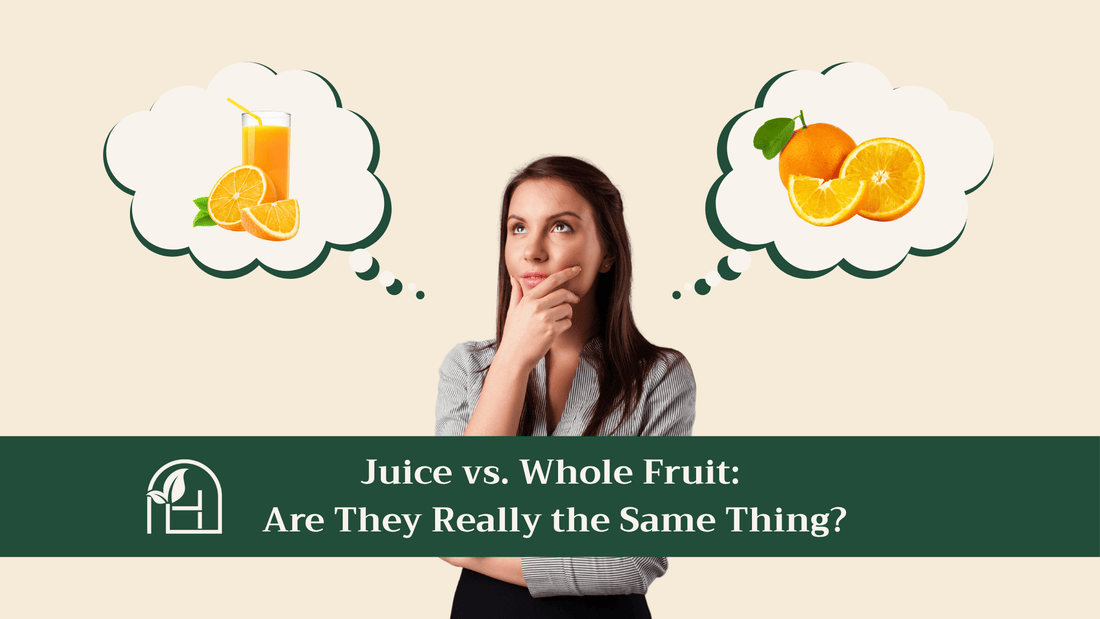
Juice vs. Whole Fruit: Are They Really the Same Thing?
🍊 The Great Fruit Debate: To Juice or Not to Juice?
Let’s be honest—fruit juice sounds healthy. It’s made from fruit, right? It’s colorful, it tastes amazing, and it even says “100% natural” on the label. But here’s the thing: drinking a glass of orange juice isn’t exactly the same as eating an orange.
So what’s the difference? And is one better than the other? Let’s peel back the layers (pun totally intended).
🍎 Whole Fruit: Nature’s Original Snack
Whole fruits—like apples, berries, bananas, and oranges—are little nutrition powerhouses. They’re packed with:
- Vitamins and minerals (like vitamin C, potassium, and antioxidants)
- Fiber, especially in the skin and pulp
- Water, which helps hydrate you naturally
- Natural sugars, balanced by fiber so they’re absorbed slowly
What makes them so great?
The fiber in fruit slows down how fast your body absorbs sugar. That means your blood sugar stays steadier, and you stay fuller for longer. Chewing also gives your brain time to realize you’re full—bonus!
🥤 Fruit Juice: The Sweet, Squeezy Cousin
Fruit juice—especially fresh-pressed or 100% juice—does contain some of the same vitamins as whole fruit. But here’s where things get tricky:
- Most juices have zero fiber
- They’re often concentrated sources of sugar
- It’s very easy to drink a lot, fast
Think about this:
It takes about 3-4 oranges to make one glass of orange juice. Would you sit down and eat 4 oranges in a row? Probably not. But it’s very easy to drink that juice in one minute—along with all the natural sugar and none of the fiber.
Pros and Cons: Juice vs. Whole Fruit
| Aspect | Whole Fruit 🍏 | Fruit Juice 🧃 |
|---|---|---|
| Fiber | High – keeps you full & supports digestion | Very low or none |
| Sugar | Natural, slower absorption | Natural, but quickly absorbed |
| Vitamins | Rich in nutrients | Some, but can degrade over time |
| Calories | Moderate | Can be high in large amounts |
| Convenience | Needs washing/peeling/chewing | Quick and easy |
| Fullness Factor | Satisfying | Not very filling |
🧠 But Wait—Is Juice Always Bad?
Not necessarily! A small glass of fresh juice can be part of a healthy diet, especially if:
- You use it as a complement, not a replacement, for whole fruit
- You limit the portion (about 120–150 ml or half a cup is plenty)
- You make it yourself, so you know what’s inside
- You combine it with a meal, not sip it solo like soda
For kids, juice should be occasional. For adults, think of it more like a treat or vitamin boost—not a daily must-have.
💡 The Takeaway: Chew More, Sip Less (Most of the Time)
Whole fruits win the health race almost every time. They’re more filling, slower to digest, and offer nutrients in their most balanced form. Juice? It’s sweet, refreshing, and not evil—just easy to overdo.
So next time you’re deciding between a glass of apple juice and the real thing, ask yourself: “Would I eat three apples right now?” If the answer is no... maybe go with one crunchy, delicious apple instead.
Your body will thank you—and your blood sugar will too.
